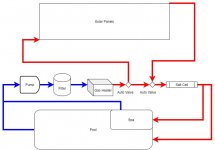- Jul 1, 2021
- 6
- Pool Size
- 15030
- Surface
- Plaster
- Chlorine
- Salt Water Generator
- SWG Type
- Hayward Aqua Rite (T-15)
Hi folks,
I have a new build and the initial system startup was just completed last week. Our system has both a gas heater and a solar panel heating array installed--the gas heater is plumbed directly off our filter and the solar heater follows the gas heater. My concern arises from the sequencing of the gas heater and solar array, which contradicts every diagram I have ever seen. Does the gas heater / solar heater plumbing sequencing matter?
This simple diagram shows the plumbing configuration of our equipment (blue lines = cold water. red lines = hot water):
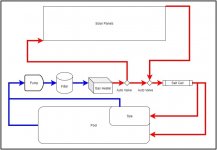
From the pool/spa the plumbing goes through the pump to my filter and directly into my gas heater. After the gas heater, there are a series of auto valves that either flow directly back to the pool / spa or can divert water up through the solar panel array before returning to the pool/spa.
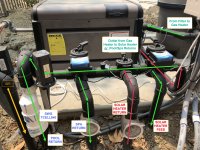
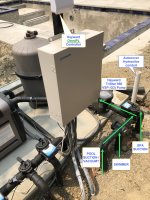
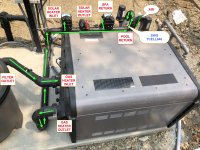
What concerns me is every diagram I have been able to find shows the solar heater array in line prior to the gas heater (example below). This sequencing seems more logical to me, but what do I know? So I'm coming to the experts...help!
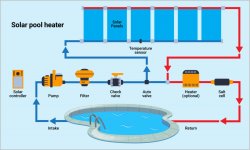
Do I have an issue here? Or is the current configuration of my system acceptable?
Thanks in advance!
I have a new build and the initial system startup was just completed last week. Our system has both a gas heater and a solar panel heating array installed--the gas heater is plumbed directly off our filter and the solar heater follows the gas heater. My concern arises from the sequencing of the gas heater and solar array, which contradicts every diagram I have ever seen. Does the gas heater / solar heater plumbing sequencing matter?
This simple diagram shows the plumbing configuration of our equipment (blue lines = cold water. red lines = hot water):

From the pool/spa the plumbing goes through the pump to my filter and directly into my gas heater. After the gas heater, there are a series of auto valves that either flow directly back to the pool / spa or can divert water up through the solar panel array before returning to the pool/spa.



What concerns me is every diagram I have been able to find shows the solar heater array in line prior to the gas heater (example below). This sequencing seems more logical to me, but what do I know? So I'm coming to the experts...help!

Do I have an issue here? Or is the current configuration of my system acceptable?
Thanks in advance!


